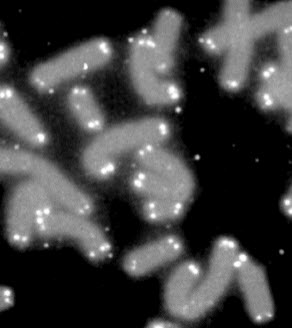Scientists extend telomeres to slow cell aging
A modified RNA that encodes a telomere-extending protein to cultured human cell yielded large numbers of cells for study
January 26, 2015

Human chromosomes (gray) capped by telomeres (white) (credit: Wikimedia Commons)
Scientists at the Stanford University School of Medicine have developed a new procedure that uses modified messenger RNA to quickly and efficiently increase the length of human telomeres, the protective caps on the ends of chromosomes that are associated with aging and disease.
Treated cells behave as if they are much younger than untreated cells, multiplying with abandon in the laboratory dish rather than stagnating or dying. Skin cells with telomeres lengthened by the procedure were able to divide up to 40 more times than untreated cells.
The procedure will improve the ability of researchers to generate large numbers of cells for study or drug development and may lead to preventing or treating diseases of aging, the scientists say.
Telomeres are the protective caps on the ends of chromosomes, which house our genomes. In young humans, telomeres are about 8,000–10,000 nucleotides long. They shorten with each cell division, however, and when they reach a critical length, the cell stops dividing or dies. This internal “clock” makes it difficult to keep most cells growing in a laboratory for more than a few cell doublings.
No comments:
Post a Comment